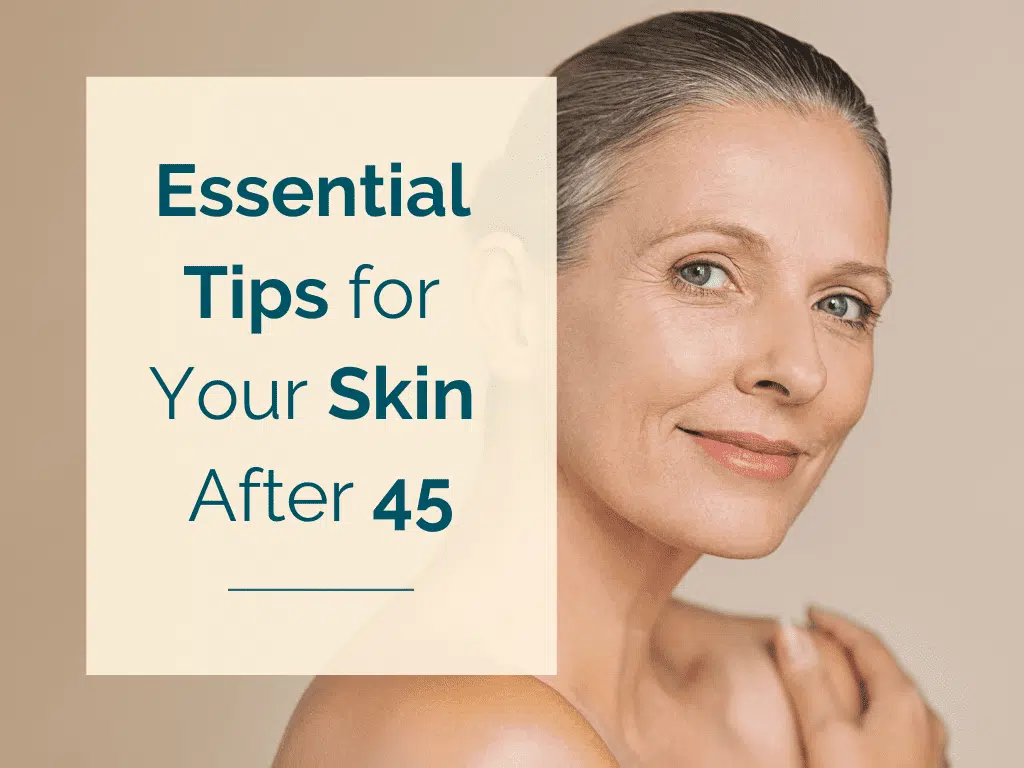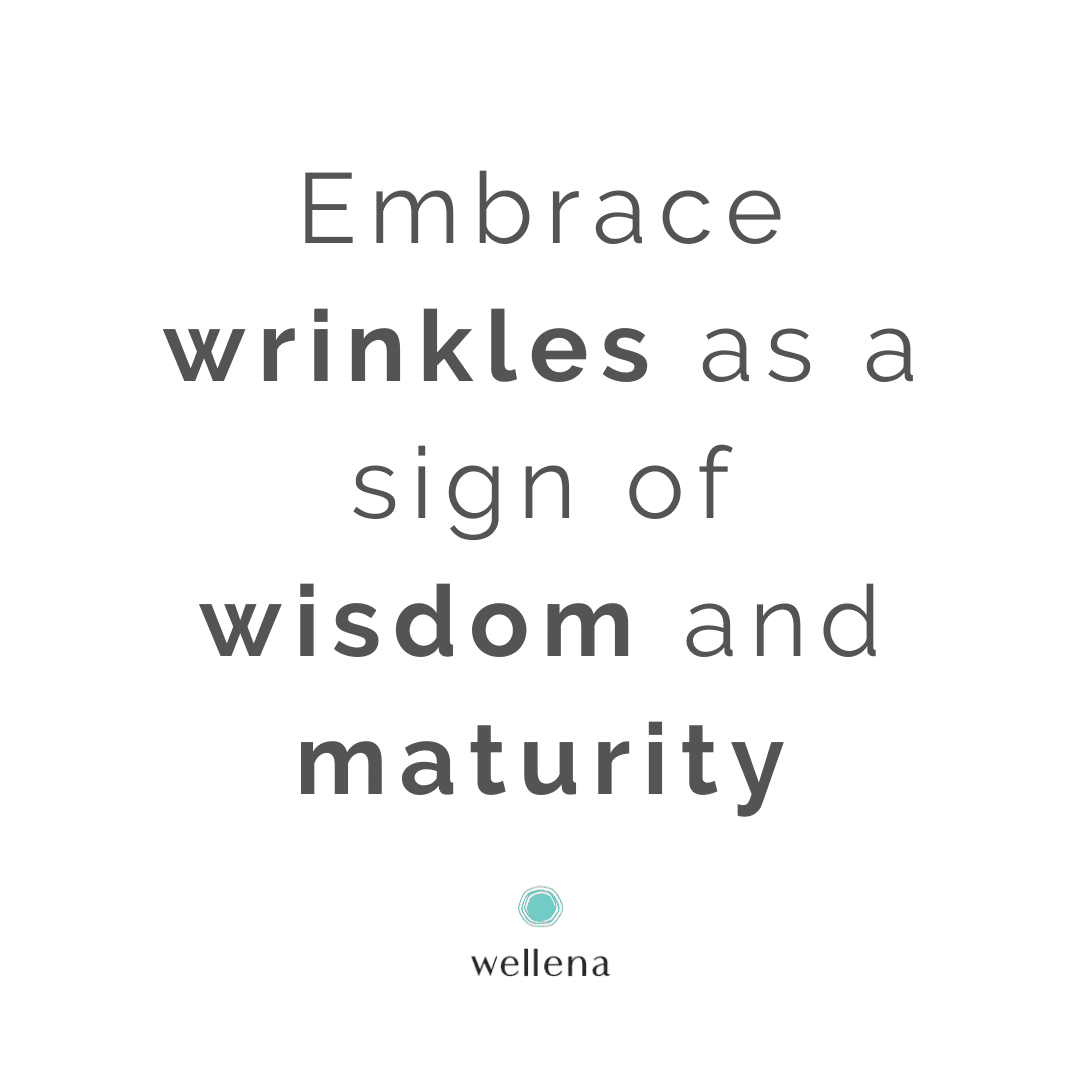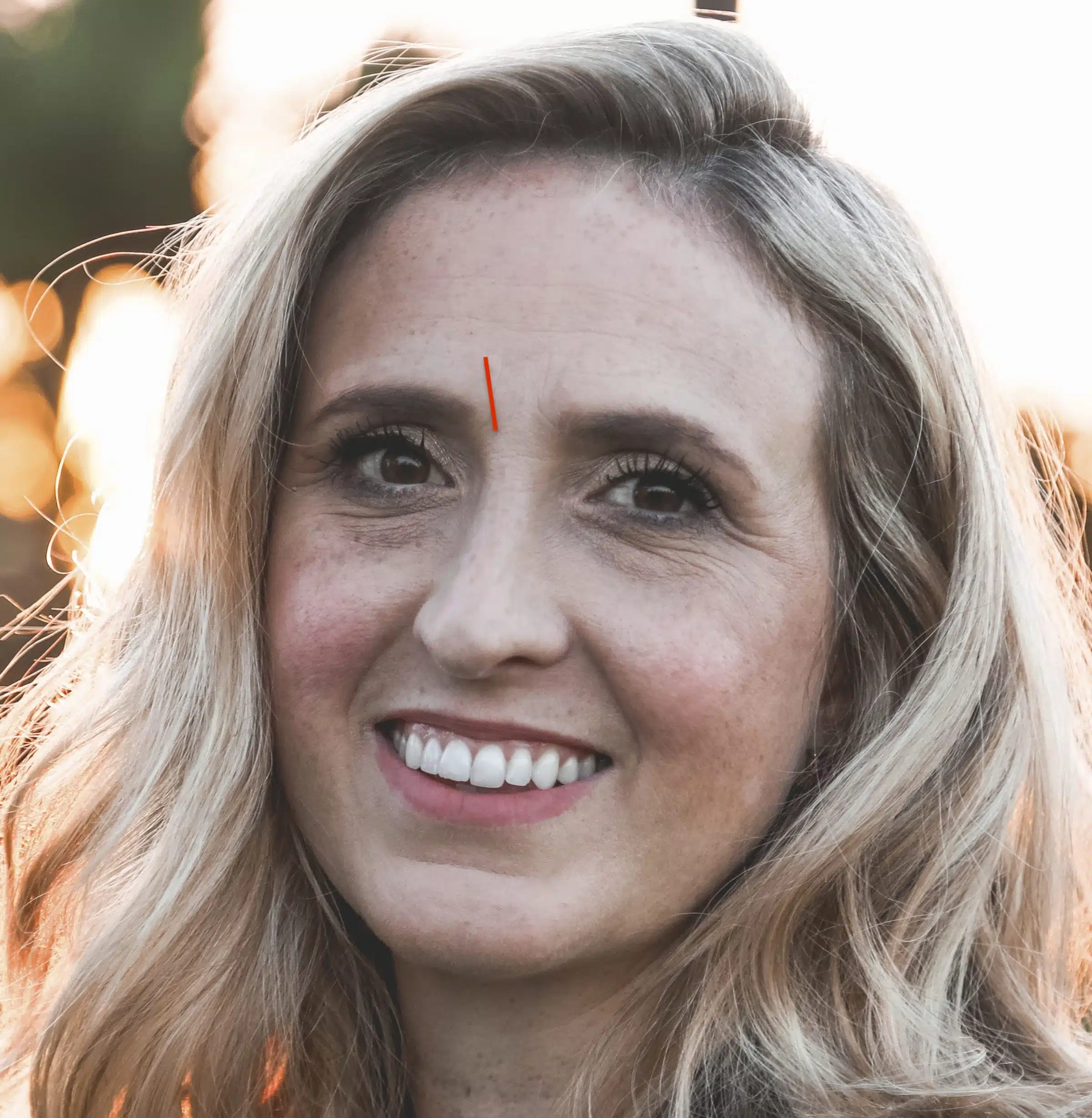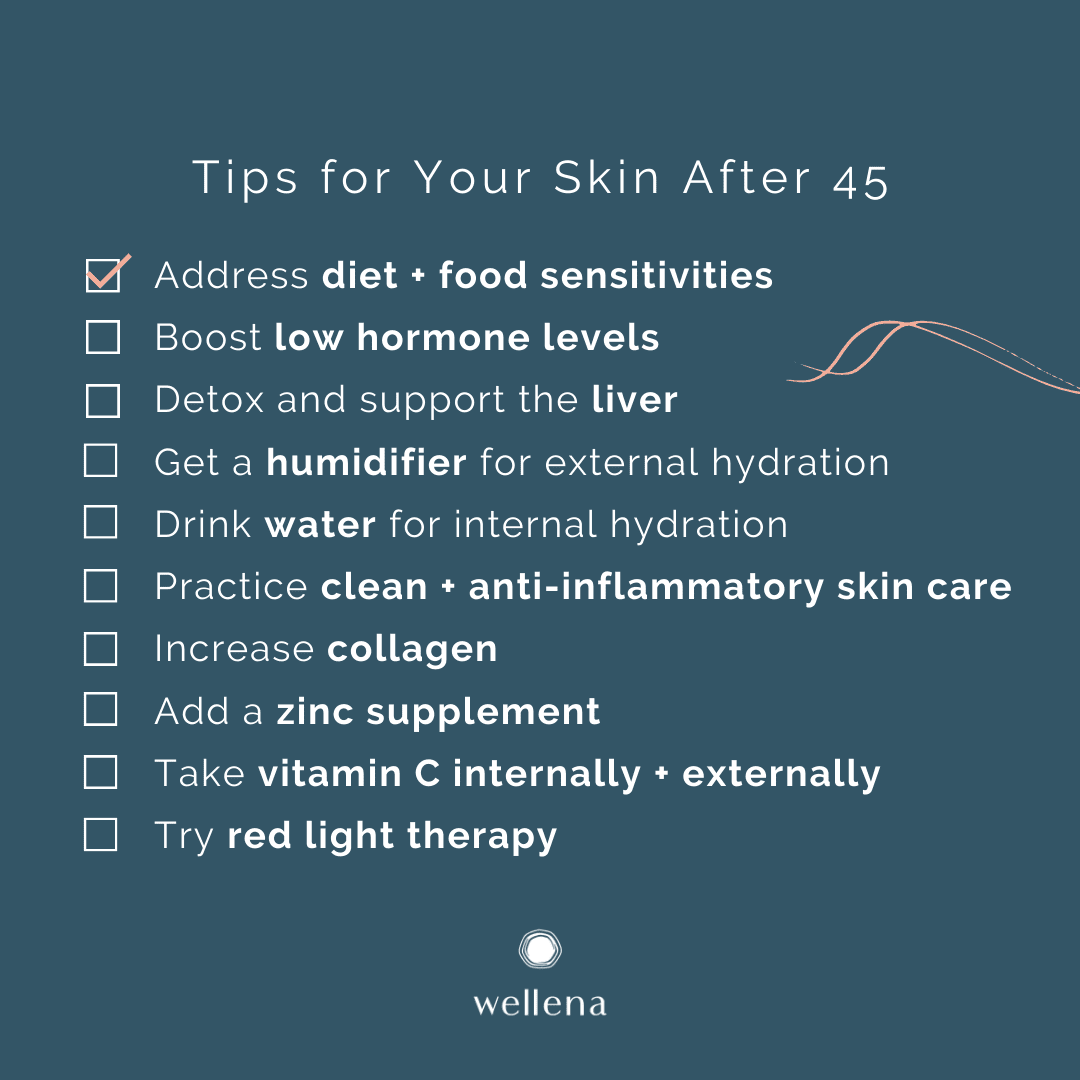
What You Will Learn in This Article
- How your diet affects your skin health
- Low estrogen and testosterone levels can lead to premature aging
- How low hormone levels can cause sensitive skin
- The liver-skin connection
- Strategies for healthy skin after 45
You can probably relate when I say that what worked in our 20s, 30s, and even early 40s doesn’t work as well as it used to. This relates to pretty much anything in women; sleep, weight, energy levels and skin. The past strategy of eating healthy, drinking sufficient water, exercising, and moisturizing may no longer result in clear, smooth, radiant skin. All of a sudden, you might be dealing with dry skin, deep eyebrow lines, discoloration, eczema, and more.
Skincare products alone aren’t going to cut it.
It’s probably bad for my business, as a skincare maker, to say that products alone aren’t going to fix your skin. But I want you to be well educated about this topic and not be disappointed if the $300 skincare products you bought don’t have the magical effects they promised.
After all, our skin is really a reflection of our inner health – I discovered it many years ago when working in advertising, with clients spanning from Neutrogena to Kielh’s to L’Oreal. Dealing with my own skin problems (cystic acne), my skin didn’t improve until I addressed the underlying causes – food sensitivities, more on that below.
We are pro-aging
One thing you won’t read about at Hormones Balance is that we are anti-aging. I feel like the anti-aging marketing taglines are defying humanity – one of the most natural and normal processes of maturing and aging. The same way we enter puberty, get a period, and enter menopause – the most natural transitions of a woman. So why defy it?
At Hormones Balance, we embrace wrinkles as a sign of wisdom and maturity. Strive for graceful and healthy aging. As you implement many of the things we suggest here, your skin will gradually improve in both health and appearance.
Our wish for you is to strive for aging with grace and beauty, and embrace it full heartedly.
Diet + Food Sensitivities
You are what you absorb, and your skin health is going to reflect your gut health, as well as the vitamins, minerals, and nutrients you’re taking in through food. A high quality, anti-inflammatory diet that’s low in sugar and rich in healthy fats and proteins is your best bet for beautiful, inflammation-free skin.
On the other hand, if you’re eating a lot of foods that promote inflammation, don’t be surprised if you have irritated, inflamed skin. If you’re eating highly processed, omega-6 rich “vegetable” oils, don’t be surprised if the oils of your skin become imbalanced and your skin is inflamed.
There’s actually a term for chronic low-grade inflammation that leads to aging: “Inflammaging.” (1) While inflammation can certainly be caused by a number of external factors (pollution, sunlight exposure, and smoking), diet has a huge impact as well.
Here are a few studies showing the impact of diet on the skin:
- A calorie restricted diet (such as fasting) slowed signs of aging (2)
- A diet rich in healthy fats is associated with better skin elasticity (3)
- Omega-3 fatty acids promote skin health and treat skin disorders (4) and a deficiency can cause dry skin (5)
- Antioxidants from plants protect against sun damage (6)
- Gluten may cause chronic hives (7), eczema/rashes, or generally irritated skin (8)
- Sugar contributes to acne (9) and to accelerated aging, due to its ability to crosslink proteins in the skin (10)
- “Vegetable oils” (rich in Omega-6s) are pro-inflammatory (11)
Additionally, if you’re eating foods that cause inflammation for you specifically (foods you’re allergic or sensitive to), don’t be surprised if your skin is inflamed or unbalanced. You may even develop a rash minutes after consuming a problematic food. Typical foods in this category include gluten, dairy, and soy, for example.
My sister had chronic issues with dry skin on her hands. For years, she tried everything topical that she could think of. None of the lotions or potions she tried seemed to make any positive difference. Finally, she removed gluten and dairy from her diet, and magically her skin improved.
Inflammation and other factors (like stress or inadequate sleep) can impact your hormone levels, which can also cause skin challenges.
Levels of Sex Hormones
Hormone levels can impact the skin in a major way. If your hormones are low, which is often the case when you hit age 45, it can impact the thickness and elasticity of your skin. That includes both lowered levels of estrogen, progesterone, testosterone, and DHEA.
Low Estrogen
Low estrogen levels can absolutely affect skin health. As you approach menopause and your estrogen production slows, your collagen production and hyaluronic acid production also go down. (12)
This more often than not leads to dry skin, wrinkles, expression lines, sagging, broken capillaries, bags under the eyes, and delayed healing. Estrogen is important for healthy skin aging, pigmentation, and oil production (13). It may also protect against sun damage (14). Basically, low estrogen contributes to the signs of aging.
Here are a few facts about estrogen as we approach menopause and postmenopause:
- Estrogen deficiency leads to thinner skin – reduced by 1.13% each year following menopause.
- Estrogen deficiency leads to decreased collagen (by 2%) each year following menopause.
- Low of skin thickness and collagen were correlated with levels of estrogen rather than actual age.
- One year of oral estrogen therapy increased skin thickness by 30% in postmenopausal women. (15)
How can you improve your estrogen levels?
One dietary change you can make is the addition of flaxseeds. Flaxseeds are a source of soluble fiber that also contain phytoestrogens. These plant-based estrogens can help boost your levels. Try making dehydrated flax crackers or adding 2 tablespoons of freshly ground flax to your morning smoothie or porridge.
Red clover functions as an estrogenic adaptogen – raising or lowering estrogen levels based on the body’s needs. Red clover contains the phytoestrogen coumestrol, a phytoestrogen that’s stronger than soy’s genistein. It also serves as an antioxidant. You can enjoy it as tea infusion.
Another remedy is the use of another phytoestrogen-rich plant, Fenugreek. According to research, fenugreek works like a natural form of Hormone Replacement Therapy (HRT) because it can raise estrogen levels while also boosting sexual arousal and desire in women. (16)
Yet another plant that can act like a natural HRT in the body is maca. This South American root will signal your body to ramp up its estrogen production if levels are low. You can learn more about the benefits of maca by reading this article.
If you’d like to give maca a try, I highly recommend Mighty Maca formulated by Dr. Anna Cabeca. Start with a teaspoon of powder and ease your way up to a tablespoon if you can. Take it every day for a few weeks and then take a break, cycling on and off. It’s easy to incorporate into your diet — you can add it to smoothies, muffins, homemade chocolate truffles, hot cocoa, and more.
Here’s a collection of maca superfood recipes to get you started.
In certain cases, you may want to consider actual bioidentical hormone replacement for estrogen. However, this requires guidance from a specialized practitioner.
Low Progesterone
Progesterone levels also gradually decline as we approach menopause. Lowered progesterone levels may cause a loss of moisture in the skin, leading to dry or cracked skin. Less progesterone in the system may also lead to more wrinkles. A natural progesterone cream may be able to help.
A 2005 study evaluated the effects of 2% progesterone cream on the health, texture, and function of skin in perimenopausal and post-menopausal women (17). The study measured skin elasticity, skin oils, moisture level, self-assessments, and measures of blood hormone levels, including estrogen, and progesterone. At the end of the 16-week study, those who used the progesterone cream had significantly improved skin elasticity and firmness, plus fewer wrinkles and depth of those wrinkles.
There are also natural ways to increase your body’s production of progesterone. To find out whether topical progesterone is right for you, take a look at these two articles:
But it’s not just the female hormones that are involved. Androgens, like testosterone, also have an impact on the skin.
Low Testosterone
For women, low testosterone levels can be a sign that you need to support your adrenal glands – DHEA and testosterone in women are produced by the adrenal glands (and testes in men). That added adrenal support could come in the form of both dietary and lifestyle changes. Review the following articles to learn how to support your adrenals:
- How Adrenal Fatigue Causes Weight Gain, Fluid Retention and Exhaustion
- 9 Herbs That Help Adrenal Stress
- Key Herbs, Vitamins, & Supplements to Restore Your Adrenals
- 6 Ways to Save Your Adrenals Postpartum
- 11 Ways Coffee Impacts Your Hormones
Once again fenugreek comes to the rescue. The University of Queensland found that taking a dose of 600 mg of fenugreek twice a day significantly increased free testosterone as well as estrogen (18).
Testosterone supports the integrity and elasticity of skin in both men and women. However, too much testosterone may lead to acne (19).
Low DHEA
DHEA is the precursor of other hormones, including estrogen and testosterone. Naturally boosting DHEA could therefore help your low estrogen or testosterone levels. A great way to do this, while also lowering stress and supporting the adrenals is the Ayurvedic adaptogenic herb, Ashwagandha.
Ashwagandha has been shown in studies to be able to increase blood levels of DHEA. In one study, it increased DHEA by 13.2% (20). However, if you are sensitive to nightshades (like potatoes, tomatoes, and eggplant), skip the Ashwagandha and opt for another beneficial herb.
There are DHEA supplements out there, over the counter. However, I don’t recommend using a DHEA supplement without the supervision of a trained practitioner. The reason for this is that DHEA can break down into harmful metabolites that can cause or contribute to estrogenic cancers. It’s really important to monitor where you are along the way with testing.
Sensitive Skin with Lower Hormones
Lower hormone levels may also set you up for more sensitive skin. At around age 50, the pH level of the skin rises, causing it to become less acidic. Normal skin pH is 5.5, so anything higher than that is out of balance. A more alkaline pH (over 5.5) leads to dry skin that is more sensitive to skin care ingredients – even ingredients that never bothered you before. (21) Some signs and symptoms of more sensitive skin include things like eczema, rosacea, redness, or tightness.
Because our ability to heal slows down as we age, that irritated skin may stay that way longer, contributing to equally irritated emotions! There are now self-order lab tests you can get, if you’re not sure what your hormone status is. Here’s an article that covers how you can get access to these lab panels.
Another consideration when your skin is irritated or plagued with chronic growths (moles, skin tags, etc) is your liver health.
The Liver and Skin Connection
I once attended a fascinating workshop about reading the face for various health ailments. One that stood out was the meaning of a deep right eyebrow line/wrinkle. You may have noticed that as you age, the line gets deeper. No matter how much product you put on it, it won’t go away. And perhaps you have noticed that during the holiday period; with more alcohol and sugar consumption, and perhaps stress, the line gets even deeper.
Meet the liver line.
I have this line too and certainly see it grow deeper if I’m not as diligent in taking care of my liver.
Other skin problems may be an outward sign of liver problems. After all, the liver is there to help eliminate toxins from the body. If that toxin elimination system gets overwhelmed, the body may start to use the skin to eliminate toxins instead. For example, non-alcoholic fatty liver disease (NAFLD) is associated with psoriasis. (22)
The following are potential signs that your liver is crying out for help:
- Acne
- Brown spots
- Rashes
- Psoriasis
- Eczema
- Lackluster or dull skin
- Itching
- Boils or moles
For a more comprehensive list of signs and symptoms, read: Symptoms of a Sluggish Liver. Getting your liver back up and running optimally is important for balancing your hormones, regulating your blood sugar levels, flushing the toxins out, and a whole lot more. Again, your skin reflects your health in general, and your liver is a key organ for restoring and maintaining vibrant health.
If your liver is in need of support, there are a number of things you can do. Check out the article How to Optimize Liver Function to Rebalance Hormones for a description of the liver’s important role and what to do to improve it.
Other Strategies for Healthy Skin
There are a number of strategies you can implement to promote healthy skin – as you age gracefully. Generally, you’ll want to lower inflammation, improve moisture, and encourage healing by including healthy proteins and fats.
Get a Humidifier for External Hydration
On colder days, we naturally tend to turn up the heat. Unfortunately, that extra radiant or forced air heat can really dry out the skin. To counteract the extra drying, consider getting a humidifier to add moisture back into the air of your home. That way, the body can retain its topical moisture balance. You may also experience other benefits, such as better sleep.
Drink Water for Internal Hydration
Be sure to hydrate from the inside as well. Our guideline given for water intake is 2/3 of your body weight in ounces per day. For example, if you weigh 150 pounds, you’ll want to shoot for about 100 ounces of water per day – about twelve to thirteen 8-ounce glasses. When you exercise, or live in a high altitude or dry environment, you need even more than that.
Keep in mind that refers to pure water, not in the form of coffee or tea. Coffee in particular can be dehydrating to the body. Make sure you have a good source of pure water that’s not contaminated with chloride or fluoride.
Another consideration is your electrolyte balance. Your body needs certain electrolyte molecules to actually get the water into your cells. That can be accomplished with an electrolyte supplement, such as Wellena’s Morning Ritual. While we need plenty of water to hydrate our skin from the inside out, it’s a different story hydrating from the outside in.
Use the Right Skincare Products
As you can see, many factors other than skincare products can and will impact your skin and graceful aging. Having said that, I think most women like the ritual of applying a safe, efficacious product on their face, neck and decolletage – as an expression of self-care and self-love. For me, it certainly is a delightful morning and before-bed ritual I cherish.
The skincare product line we formulated is USDA organic certified, uses the most gentle ingredients and is only lightly scented. The Wellena Skincare line is based on botanical ingredients such as aloe, amla, chamomile, shea butter, mango seed oil, and jojoba oil. Our hero ingredient is amla – a.k.a Indian gooseberry that is acclaimed for its extremely high Vitamin C content. Most skincare products contain 2-3% Vitamin C whereas, for example, the Wellena Vitamin C serum contains 20% of highly bioavailable vitamins C.
This explains why we’ve been getting consistent feedback from our community that the product has helped tame inflammatory skin conditions, boosted collagen levels and evened out dark spots around the eyes and face.
Increase Collagen
Collagen is the primary structural protein in the skin – it’s the “glue” that holds us together. Collagen production decreases as we age, which leads to the development of fine lines, wrinkles, sagging skin, broken capillaries, abnormal pigmentation, dry and scaly skin, brittle nails, thinning hair, and even bags under the eyes. (23)
If you want to increase collagen in your body, there are several ways you can do this:
- Use Alma fruit – when used topically, this vitamin C-rich superfood increases the production of collagen in the skin. (24)
- Use bakuchiol, an extract of the babchi plant, topically, to increase collagen production. In a clinical study, 12 weeks of twice-a-day application resulted in significant improvement in facial wrinkles, pigmentation, elasticity, firmness, and sun damage. (25)
- Add Collagen to your favorite hot or cold drinks – Our Wellena Collagen Complete is created using specific scientifically proven collagen peptide blends: Fortigel®, Fortibone®, and Verisol®.
- Add a Zinc Supplement – Zinc stimulates collagen synthesis and decreases its breakdown. Plus, it’s great for the immune system.
- Use Vitamin C – both internally as a supplement and topically as a serum. The Vitamin C Inside + Outside Kit combines both.
- Try Red Light Therapy – increases collagen production and decreases collagen breakdown. I use Red Rush 360 body light regularly. For more ideas on both internal and topical ways to increase your collagen levels, check out this article.
Summary
As you can see, skincare after 45 is a holistic practice rather than a one-of, one magical product solution. While aging is inevitable, it doesn’t have to be a steep plunge into deep wrinkles and blotchy skin. It can be a graceful glide into the next phase of life. How gracefully you glide is up to you. I encourage you to take care of your skin from the inside out:
- Make sure your diet is rich in healthy fats, proteins, and anti-inflammatory polyphenols – ones that are healthy for you.
- If your hormone levels are low, add hormone-boosting herbs as teas or supplements.
- Keep your liver happy and healthy.
- Protect yourself from excessive sun and expose your skin to red light therapy if you can.
- Boost your collagen production through the diet, product, and lifestyle changes listed above.
- Select your skincare products carefully, and make sure the ingredients are pure and beneficial. You can try our Wellena Cleanse + Nourish Kit here.
With these strategies in practice, you can look forward to aging beautifully and gracefully, keeping in mind that those smile lines are there to remind you of a life well lived.
Resources
1. Zhang, S., & Duan, E. (2018). Fighting against Skin Aging: The Way from Bench to Bedside. Cell transplantation, May, 2018.
2. Millar, S. E. Revitalizing Aging Skin through Diet. Cell. November 29, 2018.
3. Nagata, C., Nakamura, K., Wada, K., Oba, S., Hayashi, M., Takeda, N., & Yasuda, K. Association of dietary fat, vegetables and antioxidant micronutrients with skin ageing in Japanese women. The British journal of nutrition, May 2010.
4. Pilkington S.M., Rhodes L.E. Omega-3 Fatty Acids and Skin. In: Krutmann J., Humbert P. (eds) Nutrition for Healthy Skin. October 6, 2010.
5. De Mel, D., & Suphioglu, C. Fishy business: effect of omega-3 fatty acids on zinc transporters and free zinc availability in human neuronal cells. Nutrients. August 15, 2014.
6. Petruk, G., Del Giudice, R., Rigano, M. M., & Monti, D. M. Antioxidants from Plants Protect against Skin Photoaging. Oxidative medicine and cellular longevity. August 2, 2018.
7. Haussmann, J., & Sekar, A. Chronic urticaria: a cutaneous manifestation of celiac disease. Canadian journal of gastroenterology = Journal canadien de gastroenterologie. April 2006.
8. Catassi, C. Gluten Sensitivity. Annals of Nutrition and Metabolism. 2015.
9. Veith, W. B., & Silverberg, N. B. The association of acne vulgaris with diet. Cutis. August 2011.
10. Zhang, S., & Duan, E. (2018). Fighting against Skin Aging: The Way from Bench to Bedside. Cell transplantation. May 2018.
11. Fernandes G. (1994). Dietary lipids and risk of autoimmune disease. Clinical immunology and immunopathology. August 1994.
12. Varani, J., Dame, M. K., Rittie, L., Fligiel, S. E., Kang, S., Fisher, G. J., & Voorhees, J. J. Decreased collagen production in chronologically aged skin: roles of age-dependent alteration in fibroblast function and defective mechanical stimulation. The American journal of pathology. June 2006.
13. Thornton, M. J. Oestrogen functions in skin and skin appendages. Expert Opinion on Therapeutic Targets. June 2005.
14. Stevenson, S., & Thornton, J. (2007). Effect of estrogens on skin aging and the potential role of SERMs. Clinical interventions in aging. September 2007.
15. Thornton, M. J. Estrogens and aging skin, Dermato-Endocrinology. April 2013.
16. Rao, A., Steels, E., Beccaria, G., Inder, W. J., & Vitetta, L. Influence of a Specialized Trigonella foenum-graecum Seed Extract (Libifem), on Testosterone, Estradiol and Sexual Function in Healthy Menstruating Women, a Randomised Placebo Controlled Study. Phytotherapy research. 2015.
17. Holzer, G., Riegler, E., Honigmann, H., Farokhnia, S., & Schmidt, B. Effects and side‐effects of 2% progesterone cream on the skin of peri‐ and postmenopausal women: results from a double‐blind, vehicle‐controlled, randomized study. British Journal of Dermatology. August 5, 2005.
18. Rao, A., Steels, E., Beccaria, G., Inder, W. J., & Vitetta, L. Influence of a Specialized Trigonella foenum-graecum Seed Extract (Libifem), on Testosterone, Estradiol and Sexual Function in Healthy Menstruating Women, a Randomised Placebo Controlled Study. Phytotherapy research. 2015.
19. Hilton, L. HRT for anti-aging: The hormones and the benefits. Dermatology Times. October 14, 2019.
20. Auddy, B., Hazra, J., Mitra, A., Abedon, B., & Ghosal, Shibnath. A standardized Withania somnifera extract significantly reduces stress-related parameters in chronically stressed humans: A double-blind, randomized, placebo-controlled study. The Journal of the American Nutraceutical Association. 2008.
21. The Derm Review. Why Skin pH Really Matters. The Derm Review website. September 2019.
22. Mantovani, A., Gisondi, P., Lonardo, A., & Targher, G. Relationship between Non-Alcoholic Fatty Liver Disease and Psoriasis: A Novel Hepato-Dermal Axis? International journal of molecular sciences. February 2016.
23. Varani, J., Dame, M. K., Rittie, L., Fligiel, S. E., Kang, S., Fisher, G. J., & Voorhees, J. J. Decreased collagen production in chronologically aged skin: roles of age-dependent alteration in fibroblast function and defective mechanical stimulation. The American journal of pathology. June 2006.
24. Fujii, T., Wakaizumi, M., Ikami, T., & Saito, M. Amla (Emblica officinalis Gaertn.) extract promotes procollagen production and inhibits matrix metalloproteinase-1 in human skin fibroblasts. Journal of ethnopharmacology. September 2, 2008.
25. Chaudhuri, R. K. and Bowjanowski, K. Bakuchiol: a retinol-like functional compound revealed by gene expression profiling and clinically proven to have anti-aging effects. International Journal of Cosmetic Science. June, 2014.



What was the fascinating workshop about reading the face for various health ailments?
Good, suggest above 66 age .